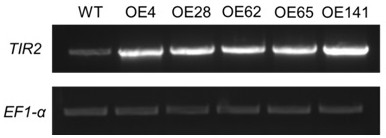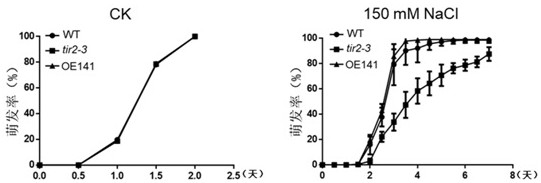Arabidopsis tir2 Application of Genes in Improving Plant Salt Stress Resistance
A technology of Arabidopsis thaliana and plant salt, applied in the field of plant genetic engineering, can solve the problems of undiscovered functions and effects, and achieve the effects of improving plant salt stress resistance, increasing growth length, and increasing germination quantity and speed
- Summary
- Abstract
- Description
- Claims
- Application Information
AI Technical Summary
Problems solved by technology
Method used
Image
Examples
Embodiment 1
[0026] Embodiment 1: Arabidopsis TIR2 Obtaining of Gene Transgenic Line OE141
[0027] 1. Arabidopsis TIR2 Acquisition of genetic mutants
[0028] Acquired in the Arabidopsis database TIR2 The CDS sequence of the gene is 1173 nt in length and encodes a protein containing 391 amino acids. The nucleotide sequence of the gene is shown in SEQ ID NO:1, and the amino acid sequence is shown in SEQ ID NO:2. Arabidopsis TIR2 Gene T-DNA insertion mutant ( tir2-3 ) was obtained from the Arabidopsis Resource Center, and then subjected to homozygous screening, expression, analysis and final identification.
[0029] 2. Arabidopsis TIR2 Obtaining of Gene Transgenic Line OE141
[0030] 1. Arabidopsis TIR2 Obtaining of Gene Overexpression Lines
[0031] (1) Construction of a constitutive expression promoter driven by 35S TIR2 The overexpression vector (35S:: TIR2 ): According to Arabidopsis TIR2 Gene CDS sequence, design gene-specific primers, the sequence is as follows (5'-3'): ...
Embodiment 2
[0047] Arabidopsis thaliana under salt stress in embodiment 2 TIR2 Effects of genes on seed germination and cotyledon unfolding
[0048] 1. Preparation of culture medium
[0049] (1) Configuration of 1 / 2MS(-) medium for plant tissue culture: weigh 2.37 g / L drug MS, 15 g / L sucrose, dissolve in ultrapure water and dilute to 1000 ml, add 1M KOH solution and dilute hydrochloric acid to adjust the pH to 5.80;
[0050] Configuration of high-salt medium: Add 58.44g / L sodium chloride on the basis of 1 / 2MS(-) medium formula, and then it can be configured as a high-salt medium containing 150 mM NaCl.
[0051] (2) Subpackage: Dispense each 200 ml of liquid medium into 250 ml Erlenmeyer flasks, add 1.6 g of agarose, and sterilize at 121°C for 20 minutes under high temperature and high pressure.
[0052] (3) After the sterilization, when the culture medium is cooled to 50-60°C, pour it into a glass plate, and divide into 10 glass plates per 200 ml. After the culture medium is solidifie...
Embodiment 3
[0056] Example 3: Arabidopsis under salt stress TIR2 Effect of genes on seedling growth phenotype
[0057] 1, the preparation of culture medium: with embodiment 2.
[0058] 2. Seedling growth phenotype detection
[0059] The medium was divided into two groups, 1 / 2 MS(-) medium and high-salt medium were added as the control group CK and the salt stress group respectively, and 4 replicates were set for each group.
[0060] Take wild-type strain WT, T-DNA mutant strain ( tir2-3 ) and the overexpressed homozygous strain (OE141) were used as treatment materials. Arabidopsis thaliana seeds with the same size and plump grains were selected at the same period, sterilized with chlorine gas for 5 hours, and then spread evenly and dispersedly on 1 / 2MS (-) medium. Seal the medium, stratify in the dark at 4°C for three days, then grow vertically at 22°C for 3 days, then select seedlings with consistent root length and transfer them to 1 / 2MS(-) medium and high-salt medium respectively, ...
PUM
 Login to View More
Login to View More Abstract
Description
Claims
Application Information
 Login to View More
Login to View More - R&D
- Intellectual Property
- Life Sciences
- Materials
- Tech Scout
- Unparalleled Data Quality
- Higher Quality Content
- 60% Fewer Hallucinations
Browse by: Latest US Patents, China's latest patents, Technical Efficacy Thesaurus, Application Domain, Technology Topic, Popular Technical Reports.
© 2025 PatSnap. All rights reserved.Legal|Privacy policy|Modern Slavery Act Transparency Statement|Sitemap|About US| Contact US: help@patsnap.com



